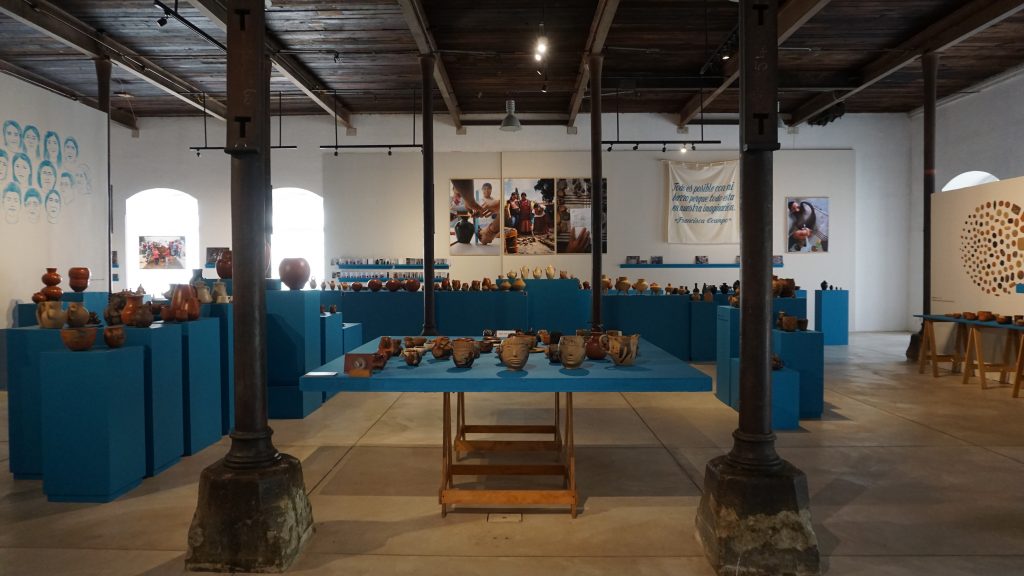In May 2023, we inaugurated"From the Earth We Are"at CaSa (Center for the Arts of San Agustín Etla, Oaxaca).
The show is a tribute to the earth that gives us life. It is also a tribute to those who, for generations, have shaped the earth with their hands, supporting the communities in an intelligent and beautiful way.

In a two-part exhibition, “De la Tierra somos” presents the living roots of traditional pottery together with new forward-looking visions.
The first section, "Fire and Clay” is a collection of traditional and functional pieces that are still being produced, from 40 of the 70 pottery villages in and around Oaxaca (culture knows no boundaries), prime examples well-balanced social and environmental design.
This exhibition displays simple and functional pottery of the indigenous peoples of Mexico. It could easily be considered rustic, and it is. It is also sophisticated, though preconceptions make it less likely to be labeled as such.


This exhibition aims to provide the viewer with tools to interpret, value, and appreciate pottery in all its depth and complexity, including its masterful design, social and cultural importance, and balance with the environment, all the while transcending narratives that confine it to merely being historical artifacts or folkloric souvenirs .
“Fire and Clay” has traveled various latitudes since it opened it in 2013 (Belgium, Helsinki, Berlin, Monterrey, Mexico City, Puebla and Michoacán), It has finally come back to Oaxaca as a permanent exhibition at the CaSa (Center for the Arts of San Agustín) founded by Francisco Toledo.

The second section, “COMALA” showcases the results, experimental practices, methodologies and learning processes of the Learning Community of Potters, a space for knowledge-sharing coordinated by Innovando la Tradición for the past five years.
Since 2017, potters from ten villages in Oaxaca, Puebla, Chiapas, and Veracruz meet once a month at the Learning Community of Potters to explore our trade with our hands, bodies, words, and clay.
This section shows COMALA’s history, lessons learned, reflections, and diversity of products, as well as the methodologies that arise from our Mountain of Learning, weaving design issues such as proportions and pottery issues such as finishes and kilns, with exercises in pricing and healthcare and reflections on land and culture.
THE MOUNTAIN
The Mountain is the pedagogical model we developed modeled on local ways of existing, doing, and learning. Each of the Mountain’s four levels encompasses questions that help us grow as individuals and collectively. Using this method, gathering as a community is just as important as sharing practical know-how of the trade or reflecting on the world around us.
COMMUNITY: How do we support each other in our processes? How do we co-create loving and trusting spaces?
CLAY: What can I create with my hands and my knowledge? How can I improve my technique or my tools?
TRADE: What type of relationships do I want to foster with my clients? In my workshop? With myself? How do I build a healthy, profitable, and strong business?
HORIZON: What does being a potter mean in the world we live in? What can I learn from the world? What do I offer the world? How can I make a difference in my environment?
The exhibition opened with a talk on the second floor that included veteran potter-maker don Polo Barranco (San Bartolo Coyotepec), Francisca Ocampo (Santa María Atzompa) and Dina Vera (Los Reyes Metzontla), moderated by Kytzia Barrera and Diego Mier y Terán, directors of Innovando la Tradición, which gave the audience a chance to listen to the thoughts of three generations of potters.


The exhibition opened with a talk on the second floor of the building, with veteran Polo Barranco (San Bartolo Coyotepec), Francisca Ocampo (Santa María Atzompa) and Dina Vera (Los Reyes Metzontla), moderated by Kytzia Barrera and Diego Mier y Terán , directors of Innovating Tradition. The public thus had the opportunity to listen to the feelings of three generations of potters.

Before opening to the public, we joined hands and celebrated this accomplishment in a great circle that brought together potters and their families, the Innovando la Tradición team, the CaSa team, and members of the Huajes Valley Network. It was a beautiful, memorable moment followed by a private tour of the exhibition that culminated in a meal for 100 people at Francisco Toledo’s house.